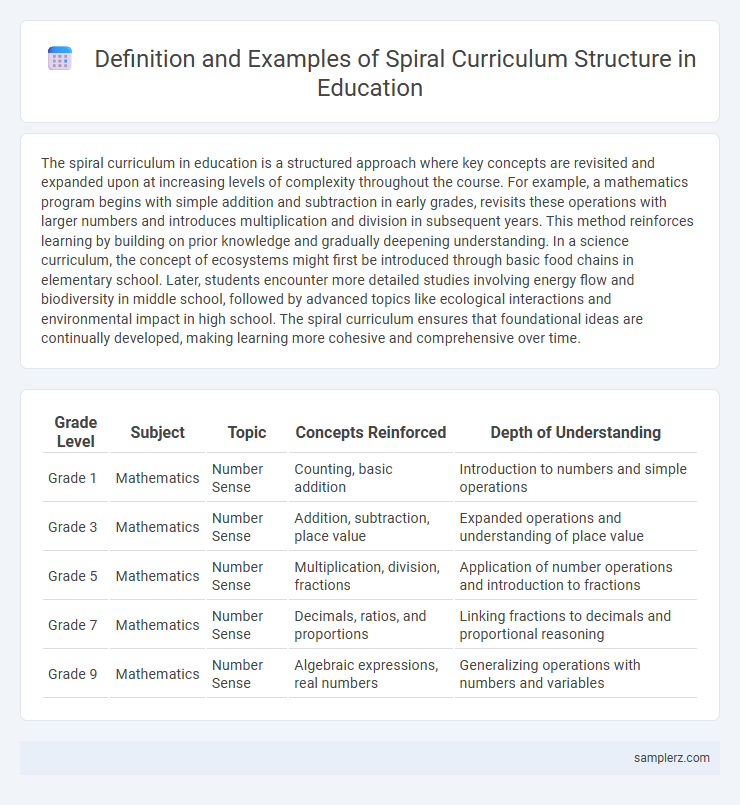The spiral curriculum in education is a structured approach where key concepts are revisited and expanded upon at increasing levels of complexity throughout the course. For example, a mathematics program begins with simple addition and subtraction in early grades, revisits these operations with larger numbers and introduces multiplication and division in subsequent years. This method reinforces learning by building on prior knowledge and gradually deepening understanding. In a science curriculum, the concept of ecosystems might first be introduced through basic food chains in elementary school. Later, students encounter more detailed studies involving energy flow and biodiversity in middle school, followed by advanced topics like ecological interactions and environmental impact in high school. The spiral curriculum ensures that foundational ideas are continually developed, making learning more cohesive and comprehensive over time.
Table of Comparison
| Grade Level | Subject | Topic | Concepts Reinforced | Depth of Understanding |
|---|---|---|---|---|
| Grade 1 | Mathematics | Number Sense | Counting, basic addition | Introduction to numbers and simple operations |
| Grade 3 | Mathematics | Number Sense | Addition, subtraction, place value | Expanded operations and understanding of place value |
| Grade 5 | Mathematics | Number Sense | Multiplication, division, fractions | Application of number operations and introduction to fractions |
| Grade 7 | Mathematics | Number Sense | Decimals, ratios, and proportions | Linking fractions to decimals and proportional reasoning |
| Grade 9 | Mathematics | Number Sense | Algebraic expressions, real numbers | Generalizing operations with numbers and variables |
Understanding Spiral Curriculum Structure
The understanding spiral curriculum structure involves revisiting key concepts with increasing complexity over time, allowing students to build on prior knowledge effectively. For example, in a mathematics curriculum, students first learn basic arithmetic in early grades, then revisit number theory and algebra concepts in middle school, and later explore advanced problem-solving and abstract reasoning in high school. This progressive layering reinforces understanding and promotes long-term retention through repeated exposure to core ideas at deeper levels.
Key Components of a Spiral Curriculum
A spiral curriculum revisits key concepts at increasing levels of complexity, reinforcing prior knowledge while building new understanding. Core components include sequencing content in progressive depth, integrating continual review, and emphasizing interconnected knowledge domains. This structure enhances retention and skill mastery by cyclically expanding on foundational ideas throughout the educational program.
Mathematics: Spiral Curriculum Example
A spiral curriculum in mathematics revisits core concepts such as number sense, algebra, and geometry across grade levels with increasing complexity and depth. This approach emphasizes mastery through iterative learning cycles, reinforcing foundational skills while introducing new problem-solving techniques. Key topics like fractions, equations, and spatial reasoning are continuously expanded, promoting long-term retention and conceptual understanding.
Science Education: Layered Learning Approaches
Spiral curriculum in science education progressively revisits core concepts such as ecosystems, matter, and energy, each time deepening students' understanding by introducing complex details and new scientific principles. This layered learning approach ensures reinforcement and retention by connecting prior knowledge with advanced content, allowing learners to build on their comprehension over multiple grade levels. Emphasizing inquiry-based experiments alongside conceptual theory enhances critical thinking and application skills within this structured framework.
Language Arts: Revisiting Core Concepts
A spiral curriculum in Language Arts revisits core concepts such as phonics, vocabulary, and grammar at increasing levels of complexity throughout the academic year. Each revisit reinforces foundational skills while introducing more advanced applications like critical reading, writing styles, and literary analysis. This structured approach enhances long-term retention and supports progressive mastery of language arts competencies.
Social Studies: Progressive Skill Building
A spiral curriculum in Social Studies revisits key themes such as government, culture, and geography at increasing levels of complexity across grade levels. Students initially learn basic concepts like community roles and gradually engage with more advanced topics such as constitutional principles and global interdependence. This progressive skill building enhances critical thinking and reinforces knowledge through repeated exposure and expanded understanding.
Technology Integration in Spiral Curriculum
A spiral curriculum in education revisits key technology integration concepts such as digital literacy, coding, and multimedia tools at increasing levels of complexity across grade levels. Early lessons introduce basic computer operations and internet safety, while subsequent units expand to project-based learning with coding languages and collaborative online platforms. This structured, iterative approach ensures students build a deep, adaptable understanding of technology's role in problem-solving and creativity over time.
Spiral Curriculum in Early Childhood Education
Spiral curriculum in early childhood education revisits key concepts such as numbers, letters, and social skills at increasing levels of complexity, reinforcing learning through repetition and progression. Structured around thematic units, lessons build on prior knowledge, supporting cognitive development and retention. This approach fosters deeper understanding by connecting new information with previously learned material, crucial for foundational skill mastery in young learners.
Assessment Strategies Within a Spiral Framework
Spiral curriculum in education structures assessment strategies by revisiting key concepts at increasing levels of difficulty, enabling continuous reinforcement and deeper understanding. Formative assessments are strategically embedded at each stage to monitor student progress and inform instruction adjustments. This cyclical approach promotes mastery and long-term retention by aligning assessments closely with the iterative learning process.
Benefits and Challenges of Spiral Curriculum Structure
The spiral curriculum structure revisits key topics like mathematical concepts or scientific principles at increasing levels of complexity, reinforcing learning and promoting long-term retention. This approach benefits students by building on prior knowledge, enhancing understanding through repeated exposure and application in diverse contexts. Challenges include the need for careful curriculum planning to avoid redundancy and ensure that each revisit adds meaningful depth, as well as the potential difficulty for educators to pace and align content appropriately across grade levels.

example of spiral curriculum in structure Infographic
 samplerz.com
samplerz.com